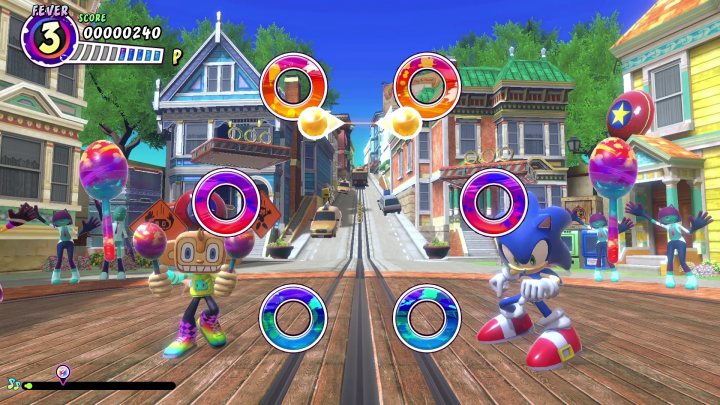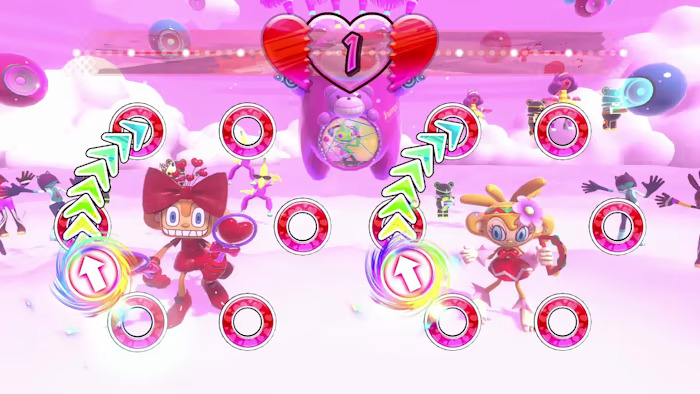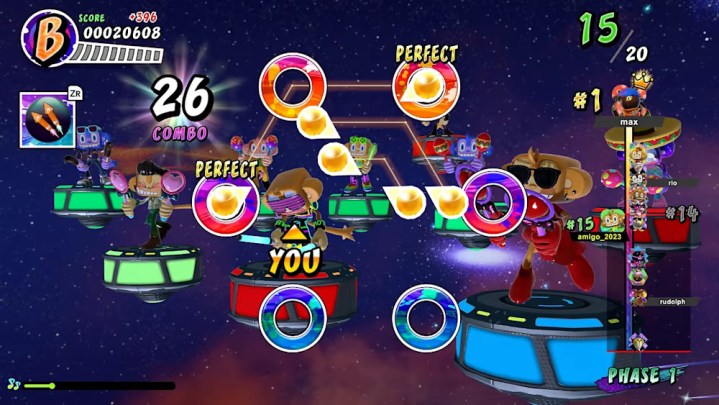I always find myself a little nostalgic when thinking back to the Nintendo Wii era. Though I had a lot of complaints at the time about forced motion controls in every game and inconsistent Wiimote waggling, I miss that golden age of party games. It’s something we’ve lost in recent years, as the Switch Lite’s incompatibility with motion controls has pushed developers back into building games around buttons. So forgive me for getting a little too excited about Samba de Amigo: Party Central.
The upcoming Switch exclusive is a revival of a classic Sega rhythm series, which has players shaking maracas along to the beat of Latin music. It’s a long-dormant franchise that we haven’t seen since 2008 when the Dreamcast version was ported to Wii and given full motion support. So a modern sequel on Nintendo Switch feels like both a total surprise and a no-brainer. With the system’s portability and easy-to-swing Joy-con controllers, Samba de Amigo: Party Central could feasibly become one of the console’s casual multiplayer staples.
I got a glimpse of that future during a sweaty, hour-long multiplayer session. Within moments of firing up a song, all the joys — and frustrations — of the waggle era came flooding back. Even if it doesn’t end up being the summer’s hottest hit, Samba de Amigo: Party Central is shaping up to be a gleefully silly return to the Wii’s golden age that’s custom-built for family game nights.
I really like you
Though Party Central is still a few months out from its August 29 release date, the build I played was surprisingly complete. During my session, I’d get to choose from a massive collection of songs, try out a small suite of minigames, poke my head into its StreamiGo! challenge mode, and flip through its cosmetic shop (all purchasable with in-game currency exclusively). The only thing I couldn’t test was its online elimination mode, which has the potential to be its crown jewel. There’s a sizable enough suite of content here for what the game is and the promise of DLC, which will bring more songs and challenges over time, should give interested players enough to dig into by the end of its support cycle.
My buddy and I would spend the bulk of our session shaking our Joy-cons in its standard multiplayer mode. Like some of the Wii’s best party games, the core hook needs little explanation: shake the Joy-cons like maracas, matching beats at the right time alongside the music. I’d need to wave my arms up, down, and to the side to hit every beat as they pass through a circular grid. In addition, players are occasionally asked to strike specific poses and complete quick minigames mid-song. One had me running in place as fast as I could to beat my friend’s distance.

Though it’s easy to pick up and play, there’s some real challenge here for rhythm game experts who want to show off. I concluded my demo by diving into Moves Like Jagger at the game’s highest difficulty level. The result was a flurry of fast, complex motions that had me on the floor by the end.
It’s an absolute workout — or at least, it is for me. While more reserved movements will register and it supports button-only controls, I find that a game like this is best treated like a fitness game. The more you throw your body into Party Central, the more fun (and funnier) it becomes. Though it does run into some problems that Wii owners might be all too familiar with. The bigger my movements, the more inconsistent the motion controls got. Sometimes I’d hit a “perfect” note by total accident. Other times one of my Joy-cons would just miss notes entirely. That’s frankly expected from a motion-controlled game and won’t matter much in a casual setting, but it is a little funny that we still haven’t evolved far past the Wii’s shortcomings.
Despite those motion quirks, the core rhythm gameplay is the exact, familiar fun I was craving from a Switch party game. And that’s especially helped along by an eclectic list of songs that span modern pop, 80s hits, and Latin staples. My session was a total hodgepodge of styles, jumping between Carly Rae Jepsen, Karma Chameleon, and Sonic Adventure 2’s Escape From the City. It feels like there’s just enough for everyone here, which should help keep adults entertained alongside their kids.
Get busy
While the core rhythm mode is the centerpiece of the package, a collection of special modes would shake up the format. Love Tester is a co-op mode where both players are judged together, occasionally having to work their rhythm circles meld together during songs. Another mode splits songs up into five rounds, where players compete to outperform one another in the majority of them. There are some sparse minigames too, like a baseball one, but likely not enough to make it a Mario Party replacement.

What’s more intriguing are the two modes I didn’t get to try. StreamiGo! acts as Party Central’s primary single-player mode. In it, players interact with a fictional, Twitch-like streaming platform and try to grow their following. That’s accomplished by completing specific challenges within songs, like getting a certain score. All the while, fictional chat comments scroll by during songs as if you’re streaming to an audience (when I shook my maraca for the first time in La Bamba it elicited a “That’s sick!” which gave me a hearty laugh). StreamiGo! seems like the meat of the package for those who want to dive in less as a party game and more as a solo rhythm experience.
And if that’s the meat, then World Party Mode is the potatoes. The unique multiplayer component matches eight people together along with 12 computer-controller players together for a multi-round elimination mode. It seems similar to Nintendo Switch Sports’ Survival Bowling and Golf, which are two of the best multiplayer experiences I’ve had on Switch. It’s a creative way to twist the competitive rhythm game formula, and it seems hectic in the right way.

I’m not expecting Samba de Amigo: Party Central to dethrone Mario Kart 8 Deluxe or Super Smash Bros. Ultimate, but it does seem to deliver something the Switch has really lacked in recent years outside of the Just Dance series. It’s a good-hearted rhythm game that understands the casual appeal of the Nintendo Wii’s golden age. At the very least, it’ll be a good game to have on deck for families who play together. Just make sure you attach those Joy-con wrist straps.
Samba de Amigo: Party Central launches on August 29 for Nintendo Switch. It’ll retail for $40, with a $50 deluxe edition.




